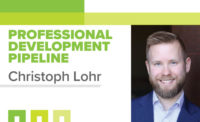Over the last year, during several webinars and in-person events, I've spoken about the idea of systems-based thinking, which incorporates the ideas of strategic thought in the form of focus (“saying no”) and identifying and executing on coherent actions. In many ways, systems thinking (a.k.a. strategy) incorporates pattern identification. I've written quite a bit about what pattern identification can look like from a gaming perspective. In this article, we will explore what systems thinking looks like when applied to engineering.
I want to note that I think for engineers, it is difficult to develop systems-level thinking. Speaking from experience, our entire education and professional lives as engineers have been spent on focusing on details and being task-focused. What that leads to, unfortunately, is decisions that only look at parts rather than the whole. At the 2021 ASPE Technical Symposium and in a previous column, I shared a story from my childhood about building the best deck, not just having the best cards. This plays itself out in engineering though, too. But rather than talking about plumbing systems, I want to review a non-construction industry engineering example.
Speaking from experience, our entire education and professional lives as engineers have been spent on focusing on details and being task-focused. What that leads to, unfortunately, is decisions that only look at parts rather than the whole
John Boyd and the Fighter Mafia out-design the USAF and Department of Defense
Col. John Boyd is a name every engineer should know. After a successful deployment in the Korean War, Col. Boyd wrote the “Aerial Attack Study.” He also later created the famous OODA loop. But in this article, I want to focus on his less discussed Energy-Maneuverability Theory (E-M Theory), which in essence, was a mathematical formula that fighter pilots could use to outwit their opponents in the skies. By increasing thrust and reducing drag, while minimizing weight, fighter planes would be able to drastically improve performance over opponent fighter jets.
At that time, the United States Air Force (USAF) held to a mindset that bigger equaled better, and to put its dollars into a single plane that could do everything. Col. Boyd had other ideas. He reluctantly assisted a like-minded colleague to develop the A-10 Warthog, one of the most influential planes in the first Gulf War. But his true crowning achievement was the creation of the F-16 Fighting Falcon. At that time, the USAF believed the F-15 fighter plane was better — and that smaller airplanes were a waste of resources. Col. Boyd (and his fellow officers/civilians who were dubbed “the Fighter Mafia”) had an uphill fight against the USAF. In part, some of the Fighter Mafia positions were:
- High technology and the focus on "higher, faster and farther" increases costs and decreases effectiveness;
- Argued for cheaper and better planes; and
- Multi-role and multi-mission capability compromise the plane.
The Fighter Mafia eventually helped General Dynamics create the F-16. The F-16, was a lighter plane that was incredibly maneuverable with faster reaction times, had a very high cruising speed, and all the while, was cheaper to produce and inexpensive to maintain. In combat and test trials, the F-16 crushed the F-15 (won on every metric) and was the unanimous choice of the test pilots. Col. Boyd’s E-M Theory was proven to be correct.
What’s worth noting here is that Col. Boyd went against conventional wisdom, but he didn’t go at it alone; he got buy-in from like-minded colleagues and created a coalition to push back. He put his ideas out there for debate, but he did take a stance based on what he thought was right.
“And you’re going to have to make a decision about which direction you want to go,” he said. Boyd raised his hand and pointed. “If you go that way, you can be somebody. You will have to make compromises, and you will have to turn your back on your friends. But you will be a member of the club, you will get promoted and you will get good assignments.”
Then Boyd raised his other hand and pointed another direction. “Or you can go that way and you can do something — something for your country, for your Air Force and for yourself. If you decide you want to do something, you may not get promoted, you may not get good assignments and you certainly will not be a favorite of your superiors. But you won’t have to compromise yourself. You will be true to your friends and to yourself. And your work might make a difference. To be somebody or to do something. In life, there is often a roll call. That’s when you will have to make a decision. To be or to do? Which way will you go?”




